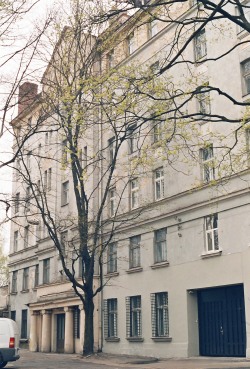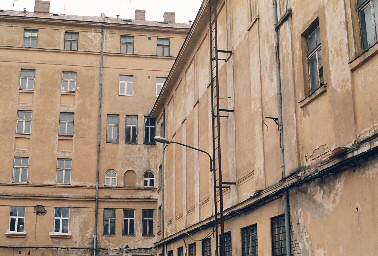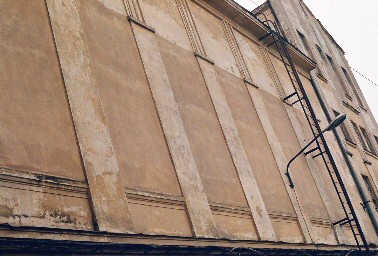
Riia Eesti Maja
The name of the Latvian capital does a small letter switch in Estonian to RIIA, the scene of Esto 2004 from June 27-30, where an Estonian House has stood since 1913. The large manufacturing centres of St. Petersburg and Riga were a huge draw for Estonians seeking work at the turn of the 20th century and close to 27 000 Estonians, including workers, students and famous cultural figures made Riga their home at the time. The first Riga Estonian Society “Imanta” was founded in 1880 and led by writer August Kitzberg and the Estonian fraternity Korporatsioon Vironia was also founded here in 1900.
Jüri Jaakson, head of the Riia Eesti Hariduse ja Abiandmise Selts or REHAS, (Riga Estonian Education and Aid Society, founded in 1908) initiated the construciton of the six-story block with meeting rooms and apartments at Nometnu iela 62 where a choir and Estonian language school were naturally the first to start up.
The building boasts a 300 square metre hall in the back where the cultural society staged elaborate plays, which received rave reviews from abroad. This hall is scheduled to be the site of an ESTO festival tradition, the SALAKÕRTS (secret pub), only that its former glory is still a bit tarnished due to the fact that during the Soviet era the building became the home of Latvia’s first television station. It thereby shared the fate of the home of the Estonian fraternity Korp! Fraternitas Estica, which was sacrificed for Tartu TV: the inside was gutted, the huge stage dismantled and its windows bricked shut. An enormous TV tower still stands above the Eesti Maja, making it easy to locate.

The back of the Riga Estonian House from its inner courtyard. Its hall is to the right.

The walls of the hall are still bricked shut.
110 members (including 12 original REHAS members) of the new Latvian Estonian Society convened in 1988 and were initially able to rent one third of the house to start up activities and an Estonian language school. After a long fight the building was finally back in the hands of its rightful owners in 1997 and renovations could begin. Next on the list is the restoration of the hall; meanwhile a lack of financial resources has led to buildings on its property, in front of and behind the Eesti Maja, being sold. Since then the small building in the courtyard has become a quaint, affordable motel. It stands next to a beautiful old market building, no doubt the regular stomping grounds of Riga Estonians up until 60 years ago.
Advertisement / Reklaam
Advertisement / Reklaam
There’s still much to do but Riga’s 3000 or so Estonians, including many businesspeople and students once again have a home. Cultural events and get-togethers are held once or twice a month and there are over 150 full-time students at the school. Riga Estonians invite you to experience a different facet of being Estonian abroad and to get better acquainted with the history and culture of your Baltic neighbours.The wooden house which stands streetside in front of the Eesti Maja was there prior to its construction in 1913.
PS > If in need of some inspiration, the greatest example of restoration to former glory in Riga is without a doubt its new House of the Blackheads Merchants’ Guild. Constructed as a public building in 1334, it was destroyed in 1941 and the Soviets succeeded in completely pulling down its ruins in 1948, because it was considered to represent “decadent” German architecture. A striking Gothic building with a Dutch Renaissance facade, it was used to house travelling, single members of the merchants' guild which had a total of 20 houses across its Hanseatic trade league routes in Latvia and Estonia. Its reconstruction was completed for the occasion of Riga’s 800th anniversary in 2001.
The first document mentioning Tallinn’s Mustpeade Vennaskond (Brotherhood of the Blackheads) dates from 1400 and the house at Pikk tänav 26 has been their home since 1406. Their name and crest reflects their patron saint, famed warrior and martyr Mauritius of Egypt. The Blackheads were quite wealthy and owned ships, yet Tallinn’s home base is a much more humble building than its counterpart in Riga. Riga has of course long been the Baltics’ largest and wealthiest metropolis. A testament to its wealth and progress has been the sacrifice of most of its old town fortifications over the centuries to make room for more stately classical and Jugendstil, or Art Nouveau buildings.
Riga’s original architectural treasure, the House of the Blackheads Merchants' Guild (Mustpeade Maja) dating from 1334, was destroyed in World War II, as were most of the buildings on its Town Hall Square. It was painstakingly rebuilt for the occasion of Riga’s 800th anniversary in 2001. In front of the building stands a newer copy of Riga’s patron saint, the knight Rolands (the original in St. Peter’s Church nearby). The square is a mix of old and new: the black box of a building to the right is the Occupation Museum, ironically the former home of the Red Riflemen’s (punaste küttide) Museum. Admission to the museum is free and its other side, facing the Daugava River, is still “protected” by 3 huge and forever controversial red riflemen. Photos: Riina Kindlam
Advertisement / Reklaam
Advertisement / Reklaam

